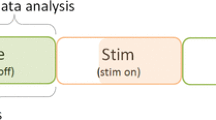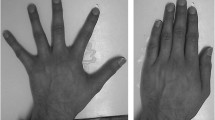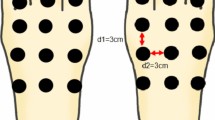Abstract
People are good at telling the direction of a moving tactile stimulus and this capacity provides a sensitive clinical test of somatosensory disturbances. Tactile directional sensitivity depends on two different kinds of somatosensory information, i.e. spatiotemporal information and information about friction-induced changes in skin stretch. The objective of this study was to compare the relative contribution to postural control of these two types of information for both glabrous and hairy skin. Postural sway amplitudes and sway paths were recorded, with or without access to tactile and/or visual stabilizing stimuli. Subjects were standing on two types of surface, either solid metal or 50 mm foam plastic. Two types of stimulus were used to generate sway-related tactile information. One was a thin air-stream that was used to assess the contribution by spatiotemporal information, and the second was a narrow steel rod that was glued to the skin to assess the contribution by skin-stretch information. The stimuli were applied to the hairy skin of the forearm and to the glabrous skin of the fingertip. In addition, we studied the ability to tell the direction of movement of an air-stream stimulus on glabrous and hairy skin. The air-stream caused significant sway reductions when applied to glabrous, but not hairy skin. The weak effect on hairy skin reflected the perceptually poor directional sensitivity for the air-stream stimulus in this cutaneous area. In contrast, the glued rod reduced sway when applied to both glabrous and hairy skin reflecting the tactile afferents’ high sensitivity to skin stretch in these areas. Both types of tactile stimulus reduced sway amplitudes more than sway paths for both hairy and glabrous skin. The visual cue, on the other hand, tended to reduce sway paths more than amplitudes. The two types of tactile receptive surface seem to influence postural control in the same manner, despite anatomical and physiological differences. The results invite speculation that patients with poor directional sensitivity might have reduced postural stability compared with healthy individuals.






Similar content being viewed by others
References
Backlund H, Olausson H, Gothner K, Norrsell U (2002) Balance through sway induced changes in glabrous and non-glabrous skin tension. Society for Neuroscience abstracts 366.8
Bender MB, Stacy C, Cohen J (1982) Agraphesthesia. A disorder of directional cutaneous kinesthesia or a disorientation in cutaneous space. J Neurol Sci 53:531–555
Bortolami SB, DiZio P, Rabin E, Lackner JR (2003) Analysis of human postural responses to recoverable falls. Exp Brain Res 151:387–404
Dichgans J, Brandt T (1978) Visual–vestibular interaction: effects on self-motion perception and postural control. In: Held R, Leibowitz HW, Teuber H-L (eds) Handbook of sensory physiology. Springer Verlag, Berlin, pp 755–804
Dickstein R, Shupert CL, Horak FB (2001) Fingertip touch improves postural stability in patients with peripheral neuropathy. Gait Posture 14:238–247
Diener HC, Dichgans J, Guschlbauer B, Bacher M (1986) Role of visual and static vestibular influences on dynamic posture control. Hum Neurobiol 5:105–113
Essick GK, Dolan PJ, Turvey TA, Kelly DG, Whitsel BL (1990) Effects of trauma to the mandibular nerve on human perioral directional sensitivity. Arch Oral Biol 35:785–794
Foerster O (1936) Symptomatologie der Erkrankungen des Ruckenmarks und seiner Wurzeln. In: Bumke O, Foerster O (eds) Handbuch der Neurologie. Springer, Berlin, pp 1–403
Hamburger HL (1980) Locognosia. The ability to localize tactile stimuli on the body surface. Doctoral thesis. University of Amsterdam
Hankey GJ, Edis RH (1989) The utility of testing tactile perception of direction of scratch as a sensitive clinical sign of posterior column dysfunction in spinal cord disorders. J Neurol Neurosurg Psychiatry 52:395–398
Holden M, Ventura J, Lackner JR (1994) Stabilization of posture by precision contact of the index finger. J Vestib Res 4:285–301
Jeka JJ (1997) Light touch contact as a balance aid. Phys Ther 77:476–487
Jeka JJ, Lackner JR (1994) Fingertip contact influences human postural control. Exp Brain Res 100:495–502
Jeka JJ, Lackner JR (1995) The role of haptic cues from rough and slippery surfaces in human postural control. Exp Brain Res 103:267–276
Jeka JJ, Easton RD, Bentzen BL, Lackner JR (1996) Haptic cues for orientation and postural control in sighted and blind individuals. Percept Psychophys 58:409–423
Johansson RS (1998) Sensory input and control of grip. Novartis Found Symp 218:45–59
Johansson RS, Vallbo Å B (1983) Tactile sensory coding in the glabrous skin of the human hand. Trends Neurosci 6:27–32
Johansson RS, Vallbo AB (1980) Spatial properties of the population of mechanoreceptive units in the glabrous skin of the human hand. Brain Res 184:353–366
Johansson RS, Westling G (1984) Roles of glabrous skin receptors and sensorimotor memory in automatic control of precision grip when lifting rougher or more slippery objects. Exp Brain Res 56:550–564
Kavounoudias A, Roll R, Roll JP (1998) The plantar sole is a ‘dynamometric map’ for human balance control. Neuroreport 9:3247–3252
Kavounoudias A, Roll R, Roll JP (2001) Foot sole and ankle muscle inputs contribute jointly to human erect posture regulation. J Physiol 532:869–878
Krishnamoorthy V, Slijper H, Latash ML (2002) Effects of different types of light touch on postural sway. Exp Brain Res 147:71–79
Lackner JR, Rabin E, DiZio P (2001) Stabilization of posture by precision touch of the index finger with rigid and flexible filaments. Exp Brain Res 139:454–464
Ledin T, Odkvist LM (1991) Visual influence on postural reactions to sudden antero-posterior support surface movements. Acta Otolaryngol 111:813–819
Magnusson M, Enbom H, Johansson R, Pyykko I (1990) Significance of pressor input from the human feet in anterior–posterior postural control. The effect of hypothermia on vibration-induced body-sway. Acta Otolaryngol 110:182–188
McNevin NH, Wulf G (2002) Attentional focus on supra-postural tasks affects postural control. Hum Mov Sci 21:187–202
Norrsell U (1973) Defects in tactile directional sensibility after forebrain commissurotomy in man. Nature 245:41–42
Norrsell U, Backlund H, Gothner K, Olausson H (2002) Body sway reduction generated by thin, stationary airstream on glabrous and non-glabrous skin. Society for Neuroscience abstracts 366.9
Norrsell U, Olausson H (1992) Human, tactile, directional sensibility and its peripheral origins. Acta Physiol Scand 144:155–161
Norrsell U, Olausson H (1994) Spatial cues serving the tactile directional sensibility of the human forearm. J Physiol 478(Pt 3):533–540
Norrsell U, Backlund H, Göthner K (2001a) Directional sensibility of hairy skin and postural control. Exp Brain Res 141:101–109
Norrsell U, Eliasson B, Frizell M, Wallin BG, Wesslau C, Olausson H (2001b) Tactile directional sensibility and diabetic neuropathy. Muscle Nerve 24:1496–1502
Olausson H, Norrsell U (1993) Observations on human tactile directional sensibility. J Physiol. 464:545–559
Olausson H, Norrsell U, Göthner K, Wallin BG (1997) Directional sensibility for quantification of tactile dysfunction. Muscle Nerve 20:1414–1421
Olausson H, Hamadeh I, Pakdel P, Norrsell U (1998) Remarkable capacity for perception of the direction of skin pull in man. Brain Res 808:120–123
Olausson H, Wessberg J, Kakuda N (2000) Tactile directional sensibility: peripheral neural mechanisms in man. Brain Res 866:178–187
Paulus WM, Straube A, Brandt T (1984) Visual stabilization of posture. Physiological stimulus characteristics and clinical aspects. Brain 107(Pt 4):1143–1163
Riley MA, Stoffregen TA, Grocki MJ, Turvey MT (1999) Postural stabilization for the control of touching. Hum Mov Sci 18:795–817
Rogers MW, Wardman DL, Lord SR, Fitzpartick RC (2001) Passive tactile sensory input improves stability during standing. Exp Brain Res 136:514–522
Sekuler R, Nash D, Armstrong R (1973) Sensitive, objective procedure for evaluating response to light touch. Neurology 23:1282–1291
Srinivasan MA, Whitehouse JM, LaMotte RH (1990) Tactile detection of slip: surface microgeometry and peripheral neural codes. J Neurophysiol 63:1323–1332
Stoffregen TA, Pagulayan RJ, Bardy BG, Hettinger LJ (2000) Modulating postural control to facilitate visual performance. Hum Mov Sci 19:203–220
Vallbo AB, Olausson H, Wessberg J, Kakuda N (1995) Receptive field characteristics of tactile units with myelinated afferents in hairy skin of human subjects. J Physiol. 483(Pt 3):783–795
Wall PD, Noordenbos W (1977) Sensory functions which remain in man after complete transection of dorsal columns. Brain 100:641–653
Weinstein S (1968) Intensive and extensive aspects of tactile sensitivity as a function of body part, sex and laterality. In: Kenshalo DR (ed) The skin senses. Springfield, pp 195–222
Wu G, Chiang JH (1997) The significance of somatosensory stimulations to the human foot in the control of postural reflexes. Exp Brain Res 114:163–169
Acknowledgements
Supported by the Swedish Research Council and the Adlerbert Research Foundation.
Author information
Authors and Affiliations
Corresponding author
Rights and permissions
About this article
Cite this article
Backlund Wasling, H., Norrsell, U., Göthner, K. et al. Tactile directional sensitivity and postural control. Exp Brain Res 166, 147–156 (2005). https://doi.org/10.1007/s00221-005-2343-5
Received:
Accepted:
Published:
Issue Date:
DOI: https://doi.org/10.1007/s00221-005-2343-5




